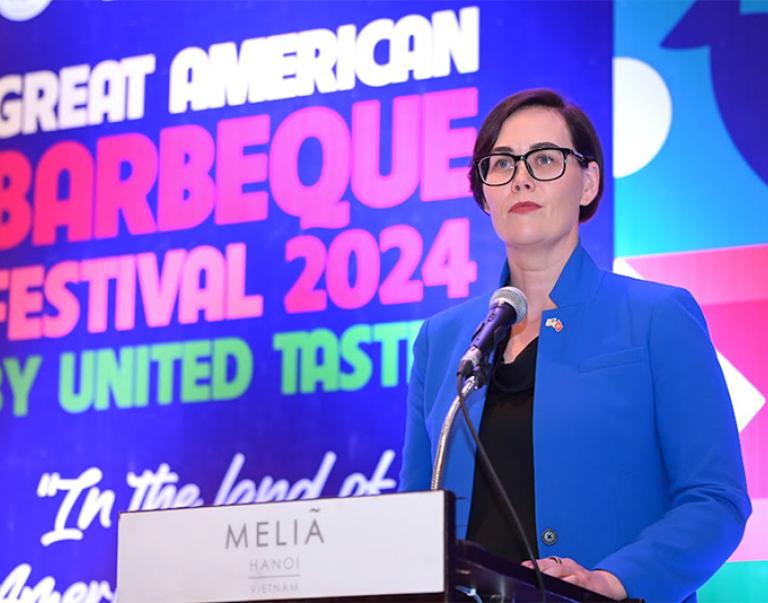In Eastern Kentucky, USDA Launches Relending Program to Reduce Rural Poverty Nationwide
BEREA, Ky., Oct. 6, 2016 – Agriculture Secretary Tom Vilsack today unveiled an innovative partnership with community development organizations from across the country, providing $401 million of Community Facilities program funds to recipients with a track record of successful programs to help reduce poverty in some of the nation's poorest and most isolated rural communities. Twenty-six community development organizations have been approved to draw upon the funding to provide long-term, low-interest financing to be "re-lent" to local entities to build, acquire, maintain or renovate essential community facilities. The funds also can be used for capacity building and to finance essential community services, such as education, health care and infrastructure.
Many of the projects will be in some of the nation's poorest rural areas, such as communities in Appalachia, the colonias along the U.S./Mexico border, and in the Mississippi Delta region. Long-term poverty disproportionately affects rural areas. Nearly nine out of 10 counties where 20 percent or more of the population has lived in poverty for 30 years or more are rural.
"This effort builds on our commitment to lifting up the economic prospects of communities that have not benefited from the revitalization of rural America," Vilsack said. "By engaging with local and national partners, private-sector financial institutions and philanthropic organizations, USDA will inject a game-changing level of investment capital to reduce poverty in targeted rural areas where the capacity for growth has not been realized. As we have seen with the Obama Administration's Promise Zone initiative and USDA's StrikeForce effort, targeted, place-based investments can have a real impact on reducing poverty. This funding adds another important tool in that fight."
The financing has two unique features. First, private financial institutions, including Bank of America and others, will be providing guarantees for a portion of the loans. Second, the recipient community development organizations, or "re-lenders," may also have an opportunity to secure grants provided by seven of the nation's premier philanthropic organizations through a $22 million fund to assist in managing and capacity building. The Mary Reynolds Babcock Foundation will manage this grant fund.
Vilsack made the announcement at Berea College, which has received USDA funding to help businesses become more energy efficient. Earlier this year, the town of Berea received a $10 million Community Facilities loan to renovate and expand the city hall and public safety facilities.
The town of Berea has played an integral role in USDA's place-based initiatives. Last year, it was chosen as one of 10 pilot sites for the Rural Integration Models for Parents and Children to Thrive (Rural IMPACT) demonstration project. Rural IMPACT helps communities adopt a two-generation approach to addressing the needs of vulnerable children and their parents. Its goal is to increase parents' employment and education and improve the health and well-being of families.
The project is led by the U.S. Department of Health and Human Services in collaboration with USDA, the Department of Labor, the Corporation for National and Community Service, the Appalachian Regional Commission, the Delta Regional Authority, the Annie E. Casey Foundation, the W.K. Kellogg Foundation and other philanthropic partners. The members of this public/private partnership have selected 10 local and tribal communities and placed AmeriCorps VISTA members there to provide technical assistance and capacity-building resources to reduce child poverty. At a White House Rural Forum convened in State College, Pa., earlier this week, the partners announced that the AmeriCorps VISTA members will remain in the 10 communities for a second year.
USDA expects the financing announced today will serve as a catalyst for additional investment. Many of the community developers already have established relationships with other private and philanthropic funders. The ability to relend money could foster greater leveraging of private and philanthropic investments in rural communities.
USDA Rural Development has a $215 billion loan portfolio and offices in every state in the nation. The agency annually invests $30 billion, on average, in rural communities.
Since 2009, USDA Rural Development (@USDARD) has funded nearly 9,200 community facilities such as schools, public safety and health care facilities; invested nearly $13 billion to start or expand nearly 112,000 rural businesses; helped 1.1 million rural residents buy homes; and helped bring high-speed Internet access to nearly 6 million rural residents and businesses. USDA also has invested $31.3 billion in 963 electric projects that have financed more than 185,000 miles of transmission and distribution lines serving 4.6 million rural residents. For more information, visit www.usda.gov/results.
To read more about USDA's investments in rural America and its successful turnaround, visit USDA's entry on Medium.com, Rural America Is Back in Business.
#
USDA is an equal opportunity provider, employer and lender.



